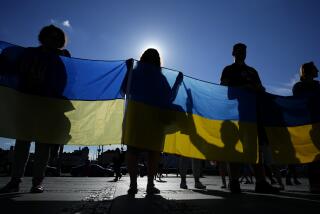Is the ‘Glasnost’ Half-Full or Half-Empty?
- Share via
Should Americans be impressed by the winds of change that are evident in the Soviet Union--or depressed by the fact that old police-state methods remain so deeply rooted?
The good-news/bad-news syndrome is not of course limited to events in the Soviet Union.
In America, Establishment politicians like to talk about the progress already made by blacks, women and other minorities. Civil-rights activists prefer to focus on how far we have to go before achieving truly equal opportunity.
Or take the racial policies of the South African government. Should Pretoria be given any credit for the modest moves that it was making away from old-style apartheid before the cycle of repression and violence and counter-violence became the order of the day? Or should we focus only on the underlying structure of racial oppression that the regime is bent on perpetuating?
It’s the old argument over whether the cup is half-full or half-empty. It’s both, of course. The trick lies in striking a sensible appreciation of what has been accomplished and what remains to be done.
Since Mikhail S. Gorbachev moved to the pinnacle of power, dramatic changes have been promised in the relationship between the Kremlin and the Soviet people--and between the Soviet Union and the West.
To a degree, the promises already have been backed up by performance--but only to a degree. The question is whether the changes are real or cosmetic--and, if real, whether they are the prelude to a far-reaching democratization of the whole system of Communist rule, Soviet style.
Western observers would be foolish to ignore the evidence that Gorbachev is indeed a new and less autocratic sort of Soviet ruler. But they would be equally foolish to assume that anything resembling U.S. democracy, or even democratic socialism of the European variety, is in sight.
Let’s look first at the positive evidence. Since Gorbachev moved into the Kremlin version of the Oval Office, some encouraging things have happened.
The Kremlin, under the banner of glasnost , or openness, is encouraging the Soviet press to be more courageous in the exposure of wrongdoing by party and government bureaucrats. Restraints on the arts are being relaxed; Boris Pasternak’s novel, “Dr. Zhivago,” is to be published in his own country at last.
Jewish emigration is seemingly on the rise. Just last week the regime announced the release of 140 dissidents, and Soviet officials say that the basic law under which dissidents were jailed is under review. Gorbachev has made great progress toward convincing people that he wants arms control and President Reagan doesn’t.
But the actual significance of the Kremlin’s supposed moves toward democratization remains open to question. Gorbachev and his colleagues would have a rough time if they had to face the sort of skeptical questioning from newsmen and parliamentary opponents that is taken for granted in the Western world.
Gorbachev, for example, has got a lot of mileage out of his announced policy of “openness.” And the Soviet media have in fact become more hospitable to diverse points of view--but only within limits.
The Soviet press is being encouraged to greater vigilance in exposing resistance to Gorbachev’s reforms. But you will look in vain for a single example of overt criticism of the maximum leader’s own policies.
Roald Sagdeev, a leader of the Soviet Scientists’ Committee for Peace Against the Nuclear Threat, was at UCLA last week to drum up opposition to the U.S. “Star Wars” program. A newsman observed that American scientists routinely oppose U.S. weapons programs--specifically including Star Wars--and asked whether glasnost means that Soviet scientists will mount comparable public challenges to Soviet military programs. His honest answer was, “No.”
Any U.S. President would love to have that kind of a deal.
So the Soviets announced the release of 140 jailed dissidents last week. Good--but what about the others, believed to number at least 1,000 and perhaps 5,000 to 10,000, who remain in detention?
Russian officials talk a good game about international good will and understanding. But how do you square that with their crude propaganda attempt to paint AIDS as a product of U.S. biological-warfare experiments, or the state-sponsored TV documentary that suggests American responsibility for the murder of Swedish Prime Minister Olaf Palme?
Then take the Kremlin’s concerted effort to convince West Europeans that the Soviet military posture is basically defensive--that Europe from the Atlantic to the Urals would be a zone of peace if only the troublesome Americans would stop threatening the Soviet Union.
Sir Geoffrey Howe, the British foreign secretary, sounded a relevant note of caution last month. He recalled the Soviet occupation of the Baltic states; the use of Soviet tanks to crush restiveness in Budapest, Prague and East Berlin; the military pressure brought on the Polish government to suppress the Solidarity movement, and the invasion of Afghanistan.
“How can we be sure,” he asked, “that the Soviet leaders will never use their forces against the West? Or try to blackmail us with the threat of those forces?
“Of course,” he added, “the Soviet Union is entitled to defend itself. But we are bound to ask why the Soviet military posture in Europe is so dominated by offensive weapons . . . . Why does Soviet doctrine lay so much emphasis on preemption? Why do the weapons and military doctrine match so closely what is needed for a swift, offensive strike against Western Europe?”
Why, indeed?
The West would be foolish to write off the possibility of genuine changes in both the Soviet Union’s foreign policy and its domestic arrangements. The door must always be kept open to a real live-and-let-live brand of peaceful coexistence.
Surely, however, we should hold Gorbachev & Co. to the same standard of credibility that we apply to our own democratically elected leaders. And if we do, the cup assuredly may be half-full--but it’s also half-empty.
We are entitled to keep on reminding the Soviet Union, as we remind white South Africans and the complacent folk in our own society, that progress must be measured not just by how far they have come but also by far they have to go.
More to Read
Sign up for Essential California
The most important California stories and recommendations in your inbox every morning.
You may occasionally receive promotional content from the Los Angeles Times.










